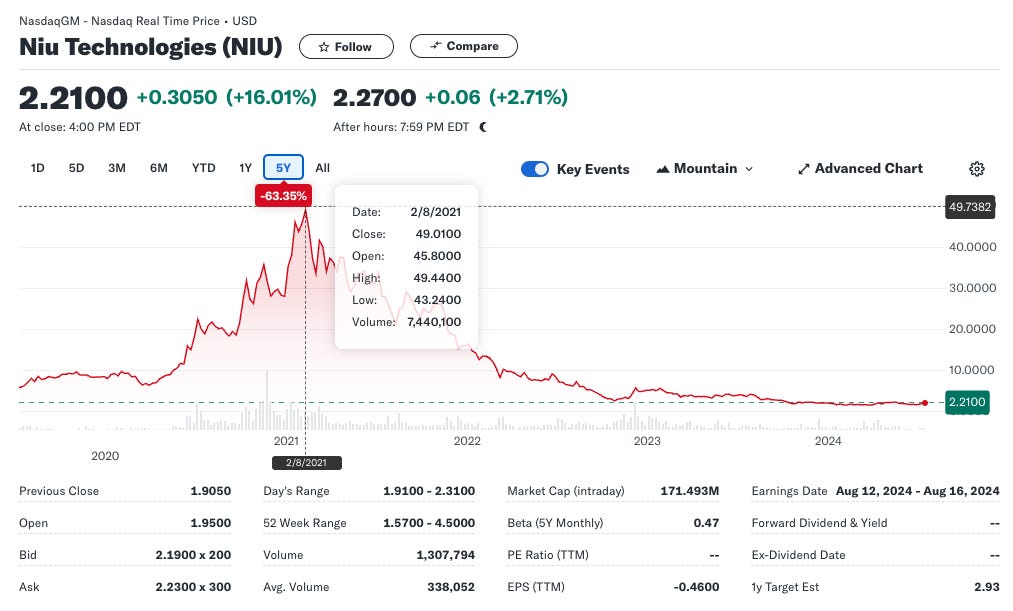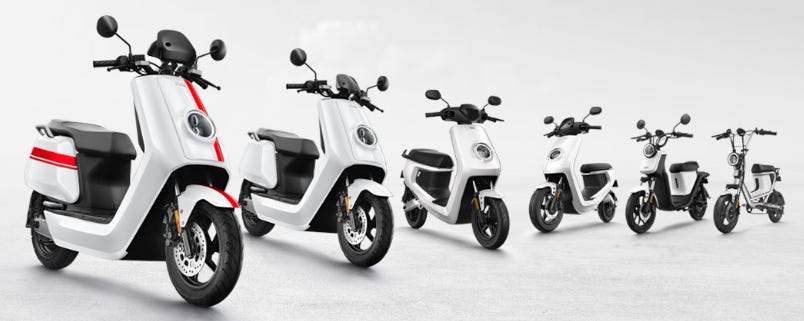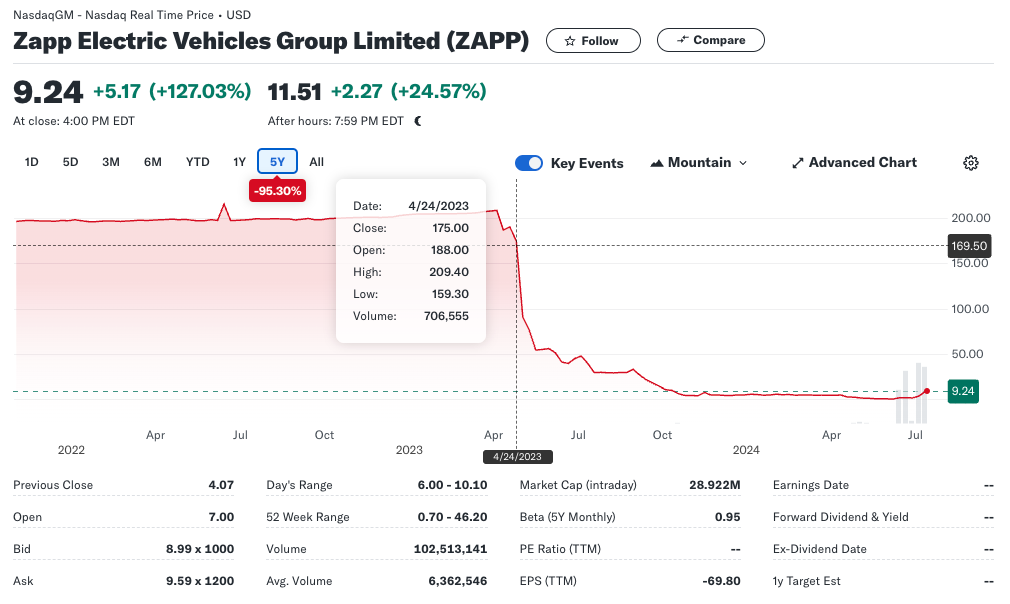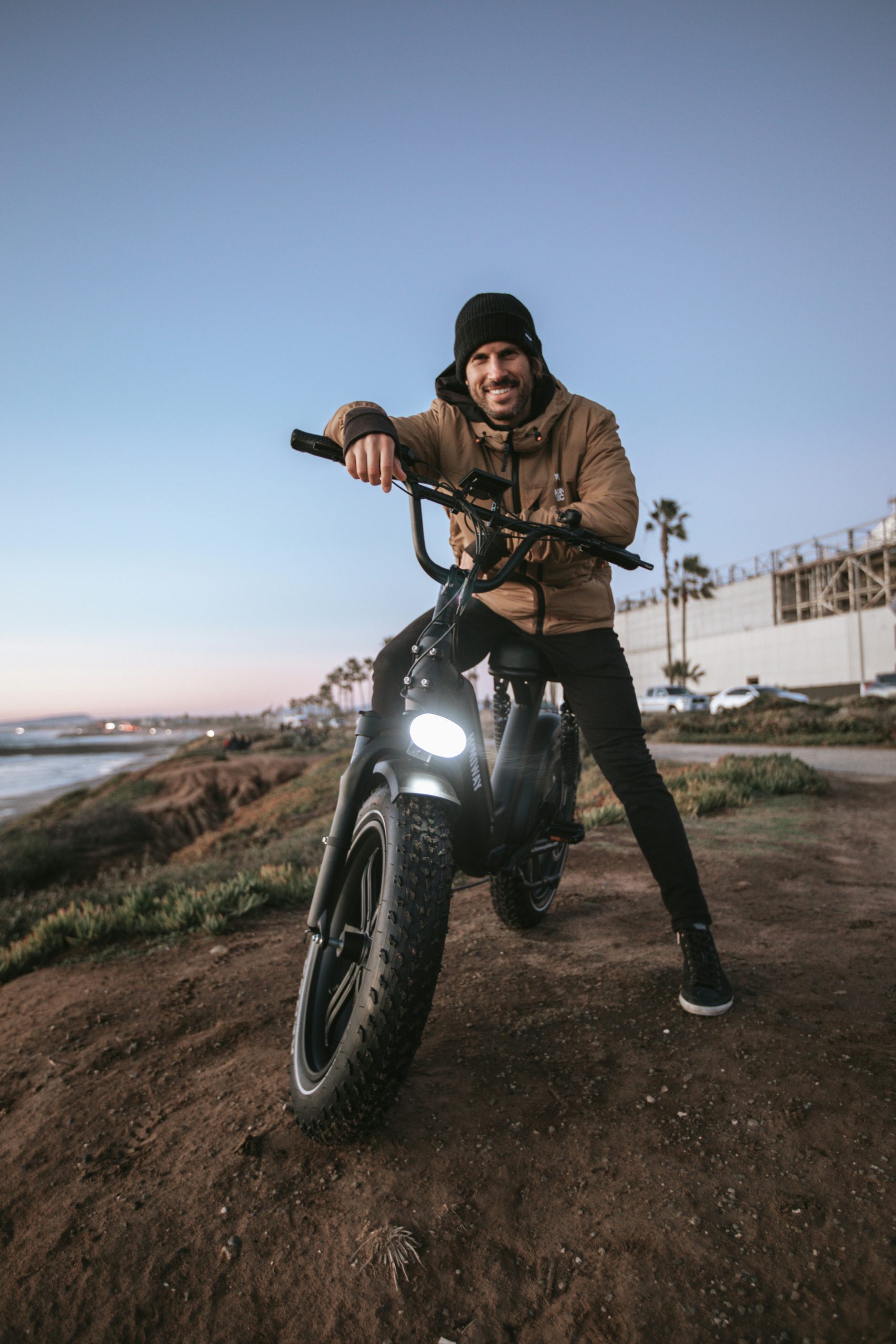With the biggest-ever E2W IPO around the corner, we started looking at the fortunes of the few publicly traded electric two-wheeler manufacturers last week. It seems none of them is doing too well.
Livewire is still a shining beacon for the industry, with a market cap of around USD 1.5bn, but they are bleeding heavily, and it is a matter of time before this lofty valuation crashes.
Meanwhile, the weird niche players like Arcimoto and Volcon are either insolvent or hurtling towards that.
We continue the discussion this week by looking at Niu and Zapp, two very different stories.
Niu (NASDAQ: NIU)
Of the few high-quality Chinese brands around, Niu has made a unique name for itself. It is one of the few Chinese brands that has received certification to retail its scooters in the US. The Niu NQi Series headlamp and front apron design often give it instant recognition, and the company is using the same headlamp styling in some other models to provide the range with a family identity.
Niu Technologies was incorporated in 2014 and counts the ex-CTO of Baidu as a cofounder. The development of the first scooters was crowdfunded through Indiegogo, a platform they continued to use for fund-raising and test-marketing purposes.
Niu was listed on the Nasdaq in 2018 with an opening valuation of USD 700m. 2018-22 were perhaps the best years for the company despite Covid as its market cap peaked at USD 3.9bn in Feb 2021.

For some reason, the world thought electric mobility would be a strong pull in the post-COVID world. We are yet to find logic in this argument, as COVID locked up the world, removing both ICE and electric vehicles from the road.
In 2021, the earth started returning to normal, as did Niu’s market cap. However, lockdowns continued in China, affecting Niu’s sales. When Niu was on the rise, it was a market darling because sales volumes were rising fast, the brand had already established a strong presence in Europe, and Niu had approvals for the US Market. Margins were healthy, perhaps the best for a Chinese two-wheeler factory.
In a newly discovered industry, the early movers have a short-term advantage – they enter, create marketable products, and some barriers to entry. This strategy is what we call a shock & awe strategy.
When Niu entered the market, customers appreciated its uniqueness – it was the most ‘Un-Chinese’ of the Chinese brands. It focused on quality, product design, proudly displayed a BOSCH on its hub motors, and carried Li-ion batteries, a novelty for China-based manufacturers in the late 2010s. Customers loved it. Investors were dazzled. Sales accelerated, and Niu did well in entering prestigious markets under its self-brand, while other Chinese players were content with remaining ‘factories’ and white-label suppliers.
The brand became the darling of fleet operators worldwide, displacing the European brands Torrot, Askoll, and Govecs from fleet sales. The Niu signature headlamp became a common sight in cities like Amsterdam and Berlin.
Niu also invested heavily in European markets, opening solo brand outlets, something not many brands did.
That was the key – the market rewarded Niu’s focus on brand, accelerating sales, product, quality, and margins.
Then everything came under pressure. Due to COVID-19 and the shutdown in China, which extended to 2022 in some parts, sales in China were impacted.
Niu’s sales volumes decreased from more than a million units in 2021 to 737k units in 2022 and further to 610k units in 2023.

Still, this decline in sales cannot explain the 96-percent decline in share price. There is something more than the market makers see.
More than the decline in sales, Niu’s problem is its diminishing uniqueness.
The other Chinese woke up.
VMoto had already existed, targeting the same Niu customers. However, companies that were happy being factories until now—Yadea, AIMA, and SUNRA—started pushing their brands in Niu’s strongholds of Europe and other international markets. Then there are the upstarts like Horwin, Sur-Ron, and Tromox, targeting smaller niches in the broad market, all nibbling away at potential Niu sales.
Even TailG, which has been content to target developing markets like Africa until now, unveiled the TLG brand at EICMA 2023.
Seeing Niu’s success and the premium the market put on quality and brand, everyone (in China) has started revamping their range. The Lead-Acid batteries have been moving out and are being replaced by Li-ion portable batteries. Factory brands would comply by putting BOSCH motors if the customer wanted one. Overall quality levels improved significantly and could now match Niu.
Worse, thanks to the sheer size that a Yadea or TailG enjoys, they can launch new products faster, as seen with the product launches in the last two years. Meanwhile, Niu faltered, and the launches in the previous two years have been limited and not received as warmly in the international markets.
Can things get better?
We at InsightEV were once cheerleaders for Niu. It was the brand that changed the West’s perception of Chinese scooters. Yadea, TailG, Luyuan, AIMA, SUNRA, and many other Chinese factory brands should thank Niu for making ‘Chinese-made’ acceptable in Europe regarding seated scooters. We want Niu’s market cap to bounce back.
But the going is tough. Niu has been slow and distracted, focusing more on kick scooters and electric cycles (pedelecs) in recent quarters. Meanwhile, the competition is getting aggressive on the product front, and a market with low barriers to entry and little brand loyalty is not ideal for a bounce-back.
Zapp (NASDAQ: ZAPP)
If the US has its set of weirdos niche players all trying to prove something to someone, the UK is not far behind in creating brilliant products that target microscopic niches.
Enter Zapp.
When creating an electric motorcycle or scooter, there is often a correlation between the motor power and the battery capacity. If you put a 20kW motor and have it run off a 5kWh battery, you need cells that discharge at 4C. The higher the discharge rate, the more likely the cell’s lifecycle is reduced—it’s the equivalent of stressing an ICEngine at very high revs.
Again, like ICEngines, you can design a high-revving engine with specialized components, lower tolerances, and exotic materials. It would just cost a lot more.
The parallel solution in electric two-wheelers is to use more capable cells that can discharge and charge at higher C-rates. But they are expensive. The resultant higher BoM cost makes the product niche. That is the primary reason why the mainstream EV world tries to balance battery capacity and motor sizes.
Zapp didn’t attend that class.
They put in a 5.7kW motor—small, except that it can hit a peak of 14kW, so it’s not that small. But to support all that motor, they put in two teeny-weeny portable batteries, each 720Wh, for a grand total of 1.44kWh. Maybe grand is not the right word here.
That’s a nearly 10C discharge from the cells when you go full throttle. To put it in perspective, the cells on electric hyperbikes like the Lightning LS 218 and the Damon Hypersport discharge at 7C – 8C.
Nothing wrong with what Zapp is doing, except the cells must be expensive. We end up getting a scooter with an outlandish BoM (Bill of Materials) cost and (as a result) a price tag nearing EUR 10k.
![2023 Zapp i300 First Look [Award-Winning Electric Scooter]](https://insightev.com/wp-content/uploads/images/2025/01/https-3a-2f-2fsubstack-post-media-s3-amazonaws-com-2fpublic-2fimages-2f9e5b2bca-e32c-4a3a-a5d3-a14e9f40202b_1620x1080-webp.jpg)
It’s no longer a scooter designed to solve a problem – low-cost mobility, environment-friendly mobility, or whatever sails your boat. This is an out-and-out passion project with no logic, designed for the thrill.
And thrill it does. We love the Zapp for what has gone into it and its capabilities. The primary reason why a scooter designer would put such a small battery is to keep weight low. Zapp further amplifies the feeling with an innovative exoskeleton frame carved out of recycled alloy.
As we discussed a few weeks back, designing an awesome product is only a fraction of the story. Industrializing is the more significant challenge, especially for technology-focused startups like ZAPP.
Somewhere in the journey, you would run out of private capital.
Enter good old SPAC.
Zapp announced its intent to take the route in 2022 when it announced a merger with CIIG Capital Partners II, a blank check company trading on the NASDAQ, formed to effect a merger, capital stock exchange, asset acquisition, stock purchase, reorganization, or similar business combination with one or more businesses.
The merger transaction was completed in April 2023, and ZAPP started trading on 28th April. The stock opened at USD 175 and immediately began a free fall. It rests at USD 2.72 at the time of writing this report, an almost single-way drop of 98 percent.

So what went wrong?
In an ideal case scenario, as CIIG and Zapp had outlined in November 2022:
The partnership was a definitive merger agreement that reflects an estimated fully-diluted post-transaction enterprise value of $573 million, consisting of an estimated equity value of $852 million, $274 million in new cash to the balance sheet (assuming no redemptions by CIIG II public stockholders), and $5 million in existing cash.
The USD 274m in cash would have happily sailed Zapp through to series production, except we don’t see any signs of it. That means that most of the CIIG II public stockholders decided to flee when the merger with ZAPP happened.
That USD 274m evaporated. At the end of the last reported quarter, the company held a little over USD 3.8m in cash.
Since then, investors have been busy selling the stock as they realize that Zapp is a very long-term yet smaller-dimensional story. We can ‘get in’ later.
Credit must be given to the company for making all the right noises to stop the straight-line fall. It has announced management changes and hired a new Head of Operations and a new Head of Investor Relations. The senior management has also purchased its own stock to shore it up.
The company has repeatedly trumpeted its award wins and patent awards, a 1-for-20 reverse stock split, finance solutions for its Europe-based customers, and even its intended entry into high-volume, important markets like India and Southeast Asia.
However, the most important announcement we have seen is that Yorkville Advisors Global, LP will invest USD 10m in Zapp (in two tranches of USD 1.5m and USD 8.5m). This is good news for the cash-starved company, and the money would come in handy now that they are taking the scooter to production.
But investors likely see through things. There is hardly any change in the stock price trend.
The reality of the ground is different, and Zapp is still far from production. The first scooters will be delivered in the summer of 2024, and for FY 2025 (ending Sept 2025), Zapp aims to provide 5000 scooters. By its own admission, a large share of these scooters would only come through in the second half of FY 2025.
Many of the other claims don’t add up. The company announced a planned entry into important high-volume markets like India and announced a local assembly partner there. The problem is that the annual market for EUR 10k-priced scooters in India is around 10…units. Even the local assembly partner – Bounce Electric – is little known for selling scooters. That India foray is likely a paper one to shore up interest.
The Zapp scooter is a low-volume play—those interchangeable fenders, the two-piece alloy frame, and the high-discharge cells all reek of a product best suited for limited production.
Can things get better?
At times, short-term setbacks distract from long-term strategy. While we at InsightEV are not fans of projects solely fuelled by passion and little common sense regarding customer needs, we admit that Zapp has created something admirable. It needs to bring the i300 to production and find an electric niche equivalent to what Italjet has in ICE scooters.
Unfortunately, even that is not much – Italjet makes more news than sells scooters.
Saying that, this can be an excellent passion-driven company seeking to capture a fanbase, if not sales volumes. Money can also be made in keychains. What that means is that the next Zapp should be faster, lighter, scarier and not a meek animal heading to the Indian market.
We will pause here and return next week to continue this discourse with VMoto, Yadea, Jiangsu Xinri (SUNRA), and Gogoro. Not all of them are bad!
We also look at Energica and Ideanomics and where they may be heading.
We also examine Damon and its ongoing plans to go public through SPAC.


